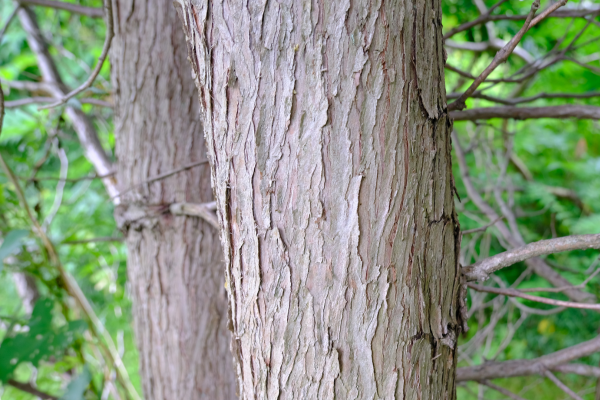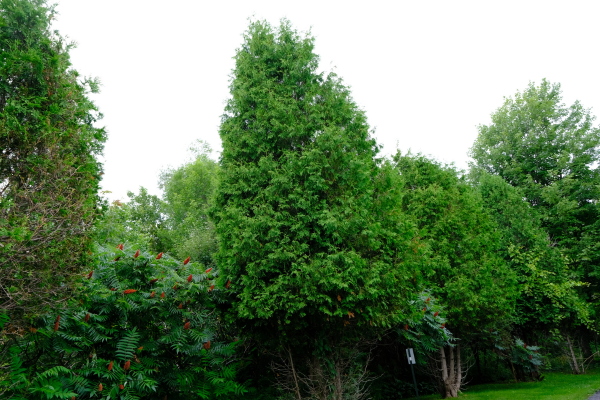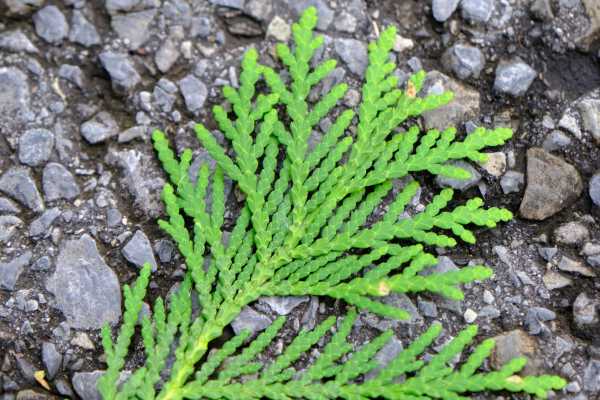Scientific name: Thuja occidentalis
Thuja = comes from the Greek word thuo, which means “to sacrifice” as cedar wood was often burned and mixed with animal sacrifices by ancient civilizations to add a pleasing aroma to the fire.
occidentalis = Derived from the Latin word occidēns, meaning “west” and ālis meaning “to grow”, therefore it means "to grow in the west."
The white cedar grows throughout Ontario in swampy areas where the underlying rock layer is limestone, which provides critical nutrients to the soil. Cedar is known for their characteristic scaley leaves that are yellowy green in colour. The tree provides shelter for a variety of birds and small mammals. They also act as a vital food source in the winter for deer, who like to browse on the small twigs, and small mammals like hares and squirrels, that feed on the stems. White cedar can live up to 200 years old but under ideal conditions can live to 700 years old. The oldest known tree in Ontario is a white cedar, growing on the cliffs of Lion’s Head Provincial Park. This tree germinated in 688 AD, making it approximately 1300 years old!
White cedar can grow in any soil type if it is moist. However, it does not tolerate road salt and should be planted in an area that will not get meltwater from roadways. While white cedar tolerates some shade, it grows best in areas with full sun. Due to its smaller size, white cedar is a popular choice for hedges in landscaping. A major pest for cedar trees is the cedar leafminer, a group of insects that feed on their foliage, causing a yellowing of the leaves. For more information about this pest see the Ontario.com Wildlife and nature page on Cedar leafminer.
White cedar is a popular wood used in carpentry as it endures most outdoor conditions. The wood is used for outdoor furniture, boats and canoes, and exterior finishes such as shingles, paneling, and fences. Oil can be distilled from their foliage and can be used as an essential oil or fragrance. White cedar oil has been used in cleaners, disinfectants, room sprays and more. Indigenous people used strips of the fragrant bark in teas to prevent illnesses such as scurvy. To learn how to make a cedar hydrosol (a water-based product made from steam distillation) from cedar leaves check this video "How to Make an Herbal Hydrosol in Your Own Kitchen Using Cedar" Please excersie caution and follow proper safety procedues with adult supervision if attempting to do this at home.
Sources:
OMNR. 2022. Ontario Ministry of Natural Resources: Ontario Tree Atlas. [online] Available: https://www.ontario.ca/page/eastern-white-cedar
OMNR. Ontario's Tree Atlas. [online] Available: https://pecmastergardeners.ca/wp-content/uploads/2020/07/Ontarios-Tree-Atlas.pdf
University of Guelph. Guelph Arboretum: Northern White Cedar - Thuja occidentalis. [online] Available: https://arboretum.uoguelph.ca/thingstosee/trees/northernwhitecedar
Henry, M. 2010. Ontario's Old Growth Forests. [online] Available: http://www.oldgrowth.ca/oldtrees/
%20938-3611%20info%40rrca_on_ca%20rrca_on_catrees%20(400%20%C3%97%20200%20px)%20(1).jpg)


 White cedar is a small to medium-sized tree that can grow to a height of 15 meters.
White cedar is a small to medium-sized tree that can grow to a height of 15 meters.  The bark of this tree is thin and reddish brown in colour when the tree is young. As the tree ages, it becomes grey and separates into flat and narrow strips.
The bark of this tree is thin and reddish brown in colour when the tree is young. As the tree ages, it becomes grey and separates into flat and narrow strips. As the tree grows, it forms a pyramid shape and densely compact. This tree got its unique shape due to browsing done by deer.
As the tree grows, it forms a pyramid shape and densely compact. This tree got its unique shape due to browsing done by deer.  The leaves of white cedar are bright green above and pale green below. The leaves are small and scaley, covering fan-shaped twigs.
The leaves of white cedar are bright green above and pale green below. The leaves are small and scaley, covering fan-shaped twigs.